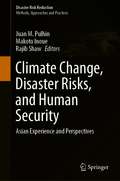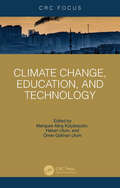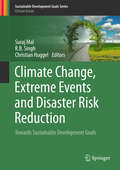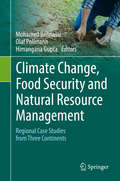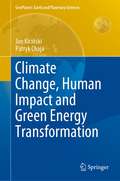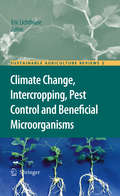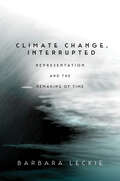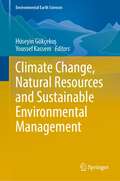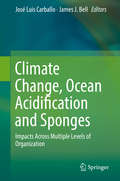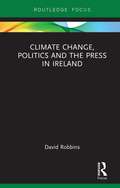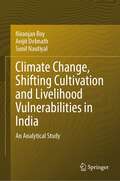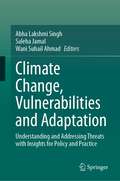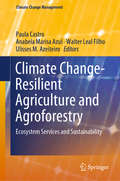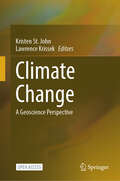- Table View
- List View
Climate Change, Climate Science and Economics: Prospects for an Alternative Energy Future
by G. Cornelis van KootenThis volume enables readers to understand the complexity associated with climate change policy and the science behind it. For example, the author describes the criticism and defense of the widely known "hockey stick" temperature graph derived from combining instrumental data and proxy temperature indications using tree ring, ice core and other paleoclimatic data. Readers will also learn that global warming cannot easily be avoided by reducing CO2 and other greenhouse gas emissions in rich countries. Not only is emissions reduction extremely difficult in rich countries, but demands such as the UN mandate to improve the lives of the poorest global citizens cannot be satisfied without significantly increasing global energy use, and CO2 emissions. Therefore, the author asserts that climate engineering and adaptation are preferable to mitigation, particularly since the science is less than adequate for making firm statements about the Earth's future climate. Readers will also learn that global warming cannot easily be avoided by reducing CO2 and other greenhouse gas emissions in rich countries. Not only is emissions reduction extremely difficult in rich countries, but demands such as the UN mandate to improve the lives of the poorest global citizens cannot be satisfied without significantly increasing global energy use, and CO2 emissions. Therefore, the author asserts that climate engineering and adaptation are preferable to mitigation, particularly since the science is less than adequate for making firm statements about the Earth's future climate.
Climate Change, Disaster Risks, and Human Security: Asian Experience and Perspectives (Disaster Risk Reduction)
by Rajib Shaw Makoto Inoue Juan M. PulhinThis book explores how climate change and disaster risks threaten human security in Asia. Climate change and disaster risks have emerged as major human security challenges in the twenty-first century, and are an imminent “threat multiplier” with the potential to harm the vital core of human life and curtail people’s freedom and ability to live with dignity. Climate change and disaster risks undermine the security of individuals, communities, nations, and the world, considering the increasing trend in the frequency and magnitude of hydro-meteorological disasters and the projections on their future adverse impacts. Despite recent advances in the literature, there is still a major gap in understanding the relationship and linkages between climate change, disaster risks, and human security, particularly as gleaned from the Asian experience. Asia is the world’s most vulnerable region in terms of the quantity and magnitude of impacts from various forms of disaster. At the same time, it has developed a number of innovative responses to address those risks, offering a wealth of experience. Exploring and capitalizing on the Asian perspective, this book provides valuable resource material for students, academics, researchers, policymakers, and development practitioners working in these areas.
Climate Change, Disaster and Adaptations: Contextualising Human Responses to Ecological Change (Sustainable Development Goals Series)
by Azizur Rahman Siddiqui Avijit SahayThis volume examines how local communities respond and adapt to ecological changes and disasters resulting from climate change. The main aim of the book is to understand the range of human responses to ecological change and to contextualise the reasons for adopting any particular adaptive strategy by a community. Through the help of specific case studies presented as individual chapters, the book aims to find out whether adaptation due to environmental stress is an individual decision and, therefore, is an isolated phenomenon, or if resilience and adaptation are part of the same action paradigm of society as a whole in response to environmental change. Of particular interest are the case studies of climate change or disasters that have rendered the site unsuitable for the return of its community at present, and thus necessitated the relocation of such communities to new locations. The case studies in the book focus on regions in India, but cover different parts of the world as well, and address concepts of resilience, vulnerability, risk, adaptation, and mitigation. The book will be useful for students and researchers in the fields of geography, disaster management, environmental science, and anthropology.
Climate Change, Education, and Technology
by Ömer Gökhan Ulum Hakan Ulum Menşure Alkış KüçükaydınThe climate change crisis is the greatest challenge humanity has ever confronted. As human activities are the most significant cause for this crisis, the solution must come from within humanity. While global movements—NGOs, universities, municipal governments, etc.—are doing their part to combat the crisis, the role of education and technology cannot be emphasized enough. Education is necessary to enhance awareness, especially among the youth, generate solutions, and implement them. Technology contributes to this process by creating climate change-fighting solutions, accumulating and analysing data, and providing energy efficiency. Technology also enables the monitoring of the climate, the mitigation of its effects, and the enhancement of the environment. Therefore, climate change, education, and the use of technology should be addressed as a unit. In this volume, the authors integrate climate change, education, and technological applications.This book is comprehensive and offers readers a variety of perspectives, encouraging the generation of novel and inventive ideas. The collaboration of authors from various disciplines to address the issue brings about novel and intriguing perspectives.
Climate Change, Extreme Events and Disaster Risk Reduction: Towards Sustainable Development Goals (Sustainable Development Goals Series)
by Christian Huggel R. B. Singh Suraj MalThis book discusses the science, causes, impacts and risk reduction strategies for climate change and disasters. It focuses on the use of traditional knowledge, new innovation and education to build a culture of safety and resilience at all levels in order to promote sustainable development goals in general and disaster risk reduction in particular. The global climate has changed substantially over the last century. There is strong evidence of global climate change in the form of increase in air and sea surface temperature, recession of glaciers, changes and shifting of climate regimes, increasing number of extreme events and sea levels changes. The increasing frequency of climate change induced disasters in particular is posing a threat to resilience, lives and livelihoods at global, regional and local levels. Major ecosystems of the world have experienced several climate induced disaster events in recent past. This book provides new insights into the occ urrence and impacts of climatic extremes and strategies for disaster risk reduction. It includes studies on rainfall and temperature trends, floods and drought disasters, weather and climatic related disasters in mountains, changes in plant activities, risk assessment and responses in different ecosystems of the world. The book is particularly useful for environmental and disaster managers, researchers and graduate students, as well as policy makers.
Climate Change, Food Security and Natural Resource Management: Regional Case Studies from Three Continents
by Mohamed Behnassi Olaf Pollmann Himangana GuptaThis book contributes to the on-going debates on climate change by focusing on the SDGs and exploring linkages between environmental change and food security as well as the relevance and need to consider the management of natural resources, especially water, soil and forest. Compared to relevant existing publications, this book covers case studies that capture the everyday realities of the local people and how they react and adapt to similar situations in different geographical settings. Each case study presented in this book gives a particular message. The strength of this book lies in the fact that it covers the most neglected topics in climate negotiations in spite of the fact that these decide the fate of millions of people around the world, especially the developing countries. By presenting a collection of case studies from Africa, Asia and Europe, this book encourages cross-continental knowledge sharing. The scope of the book ranges from impacts to mitigation and from in-field experiments to policy implementation. It contributes to the existing knowledge on climate-food nexus and connects climate change to sectors it could impact directly. All chapters in this book emphasise local ownership of strategy processes, effective participation from all levels, and high-level commitment. Besides being relevant for the academicians and scholars working in the field of climate change, forest and agriculture, it aims to catch interest of the policy makers and practitioners to understand ground realities for appropriate action. It is also bound to make an impact on the Non-Governmental Organizations around the world and in the three different continents that this book covers, considering the indigenous and local issues highlighted in this book.
Climate Change, Hazards and Adaptation Options: Handling the Impacts of a Changing Climate (Climate Change Management)
by Walter Leal Filho Gustavo J. Nagy Marco Borga Pastor David Chávez Muñoz Artur MagnuszewskiThis book addresses the issue of climate change risks and hazards holistically. Climate change adaptation aims at managing climate risks and hazards to an acceptable level, taking advantage of any positive opportunities that may arise. At the same time, developing suitable responses to hazards for communities and users of climate services is important in ensuring the success of adaptation measures. But despite this, knowledge about adaptation options, including possible actions that can be implemented to improve adaptation and reduce the impacts of climate change hazards, is still limited. Addressing this need, the book presents studies and research findings and offers a catalogue of potential adaptation options that can be explored. It also includes case studies providing illustrative and inspiring examples of how we can adapt to a changing climate.
Climate Change, Human Impact and Green Energy Transformation (GeoPlanet: Earth and Planetary Sciences)
by Jan Kiciński Patryk ChajaThis book indicates the most optimal solutions for the growing civilization problem related to climate change that takes place more and more rapidly on our planet. It is divided into two parts: In the first part, the authors - based on the available analyses and reports on climate change taking place on Earth - present their own point of view in relation to the above issue, while trying to find answers to the following questions: · Why is it so difficult to admit that humans are responsible for the ongoing climate change? · Will climate change destroy life on Earth? · Can science and modern technologies stop this process? In the second part of the book, the authors propose a solution for the advancing climate change, regarding the reduction of CO2 emissions coming mainly from the energy sector. On the basis of scientific achievements and implementations of research institutions in Poland, especially the Institute of Fluid-Flow Machinery of the Polish Academy of Sciences in Gdansk, the book proposes directions of development of the energy transformation in Poland and other countries for which fossil fuels currently make a large contribution to the energy production process and are the main emitter of CO2 to the atmosphere. The book is addressed to citizens, ecologists, climatologists as well as politicians and experts responsible for shaping the climate and energy policy of the country level and also the world.
Climate Change, Intercropping, Pest Control and Beneficial Microorganisms (Sustainable Agriculture Reviews #2)
by Eric LichtfouseSustainable agriculture is a rapidly growing field aiming at producing food and energy in a sustainable way for humans and their children. Sustainable agriculture is a discipline that addresses current issues such as climate change, increasing food and fuel prices, poor-nation starvation, rich-nation obesity, water pollution, soil erosion, fertility loss, pest control, and biodiversity depletion. Novel, environmentally-friendly solutions are proposed based on integrated knowledge from sciences as diverse as agronomy, soil science, molecular biology, chemistry, toxicology, ecology, economy, and social sciences. Indeed, sustainable agriculture decipher mechanisms of processes that occur from the molecular level to the farming system to the global level at time scales ranging from seconds to centuries. For that, scientists use the system approach that involves studying components and interactions of a whole system to address scientific, economic and social issues. In that respect, sustainable agriculture is not a classical, narrow science. Instead of solving problems using the classical painkiller approach that treats only negative impacts, sustainable agriculture treats problem sources. Because most actual society issues are now intertwined, global, and fast-developing, sustainable agriculture will bring solutions to build a safer world. This book series gathers review articles that analyze current agricultural issues and knowledge, then propose alternative solutions. It will therefore help all scientists, decision-makers, professors, farmers and politicians who wish to build a safe agriculture, energy and food system for future generations.
Climate Change, Interrupted: Representation and the Remaking of Time
by Barbara LeckieIn this moment of climate precarity, Victorian studies scholar Barbara Leckie considers the climate crisis as a problem of time. Spanning the long nineteenth century through our current moment, her interdisciplinary treatment of climate change at once rethinks time and illustrates that the time for climate action is now. Climate Change, Interrupted argues that linear, progress-inflected temporalities are not adequate to a crisis that defies their terms. Instead, this book advances a theory and practice of interruption to rethink prevailing temporal frameworks. At the same time, it models the anachronistic, time-blending, and time-layering temporality it advances. In a series of experimental chapters informed by the unlikely trio of Walter Benjamin, Donna Haraway, and Virginia Woolf, Leckie reinflects and cowrites the traditions and knowledges of the long nineteenth century and the current period in the spirit of climate action collaboration. The current moment demands as many approaches as possible, invites us to take risks, and asks scholars and activists adept at storytelling to participate in the conversation. Climate Change, Interrupted, accordingly, invests in interruption to tell a different story of the climate crisis.
Climate Change, Justice and Sustainability: Linking Climate and Development Policy
by Johannes Müller Hermann Lotze-Campen Johannes Wallacher Michael Reder Brigitte Knopf Ottmar EdenhoferAnalysing and synthesising vast data sets from a multitude of disciplines including climate science, economics, hydrology and agricultural research, this volume seeks new methods of combining climate change mitigation, adaptation, development, and poverty reduction in ways that are effective, efficient and equitable. A guiding principle of the project is that new alliances of state and non-state sector partners are urgently required to establish cooperative responses to the threats posed by climate change. This volume offers a vital policy framework for linking our response to this change with progressive principles of global justice and sustainable development.
Climate Change, Livelihood Diversification and Well-Being: The Case of Rural Odisha (SpringerBriefs in Economics)
by Arup Mitra Saudamini Das Amarnath Tripathi Tapas Kumar Sarangi Thiagu RanganathanThis book assesses the capacity of the rural populace in terms of their ability to perceive a change in climatic variables and, if so, how they react to these changes in order to minimize the adverse effect of climate change. It evaluates the role of education and exposure to change in physiological variables like temperature, precipitation, etc., in forming the right perception of climate change. While analysing livelihood diversification as a strategy to cope with climate change concerns across geography (districts), caste, education and the primary occupation of the households, the book also considers factors affecting diversification. One important aspect of well-being is consumption; thus, by focusing on consumption changes over time and relating it to livelihood diversification, the book makes an in-depth analysis of the coping mechanisms. Diversification adopted in the face of compulsion and in a situation of stagnancy may result in a range of low productivity activities, whereas diversification as an attempt to explore newer pathways in a vibrant context to reduce income risks and smooth consumption can be highly beneficial. The book, thus, focuses on job profile and occupational diversification of the sample households, the extent of instability in occupations and the distribution of households in terms of consumption pattern, the inter-temporal changes in it and the determinants. The book is useful for researchers, students in environmental studies, policy-makers, NGOs and also the common reader who wants to understand climate change, its effects on livelihoods and ways to overcome the shocks. It reflects on effective policies which can create awareness and empower people to explore opportunities for livelihood creation so that the overall is sustained if not improved.
Climate Change, Natural Resources and Sustainable Environmental Management (Environmental Earth Sciences)
by Hüseyin Gökçekuş Youssef KassemThis book is a compilation of selected papers from the Fifth International Conference on Natural Resources and Sustainable Environmental Management held in Near East University, November 2021. It provides intellectual guidance and scientific evidence on the challenges of global warming and climate change based on a humanistic and critical thinking approach, promoting research and education to build equality in the global community and more sustainable societies. This book also addresses the current challenges of bridging the gap between government policymakers and providers of science and solutions with innovative ideas and new visions to help resolve the challenges facing us in the area of natural resources (water, energy), and environment.
Climate Change, Ocean Acidification and Sponges
by José Luis Carballo James J. BellWhile sponges represent a very simple group of organisms, which are represented by over 8000 species, there is considerable interest in the increasing role they may play in future marine ecosystems. While we still have a comparatively limited understanding of how sponges will respond to ocean warming and acidification there is evidence that some species may have the ability to acclimate or even adapt to these stressors. This comprehensive collection of articles describes our current understanding of the impacts of ocean acidification and warming on sponges across multiple levels of biological organisation, and from the geological past to the present. With expert contributions from across the world this book represents the most up-to-date view on sponge responses to climate change. This book will be of interest to a wide audience of marine scientists and managers, who are grappling with how to manage, conserve and protect marine ecosystems.
Climate Change, Photosynthesis and Advanced Biofuels: The Role of Biotechnology in the Production of Value-added Plant Bio-products
by Ashwani Kumar Shinjiro Ogita Yuan-Yeu Yau Renate ScheibeThe use of fossil fuels results in rising CO2 and other greenhouse gas (GHG) emissions, causing global temperature rise and climate change that will negatively impact human health, the food supply, and eventually worsen hunger and misery. Presently, fossil fuels meet 88% of the energy demand, resulting in rising CO2/GHG emissions at alarming rates. The increased use of biofuels would help to mitigate climate change. Efficiently designing methods for the production of biofuels and plant-derived high-value products requires a deeper understanding of photosynthetic processes as a prerequisite for applying novel biotechnologies. Accordingly, this book provides ample information and a wealth of illustrative examples. The book’s eighteen richly illustrated chapters are divided into three thematic parts. I: Photosynthesis and Biomass Production under Changing Conditions, II: Microalgae and Engineered Crops for Production of Biofuels and High-value Products, and III: Genetic Resources and Engineering Methods to Improve Crop Plants. Readers will find the latest information on the molecular basis of photosynthetic processes in plants (including the regulatory principles that allow plants to maintain homeostasis under changing conditions), stress resistance and synthetic pathways. In addition, the basic principles of important biotechnologies, as well as examples of specially designed crops capable of growing under stress conditions with improved productivity, are presented. The book sets the course for future research in the field of biofuel development and production and provides both general and specific information for students, teachers, academic researchers, industrial teams, and general readers who are interested in new developments concerning the production of biofuels with value-added properties.
Climate Change, Politics and the Press in Ireland (Routledge Focus on Environment and Sustainability)
by David RobbinsMedia coverage of climate change has attracted much scholarly attention because the extent of such coverage has an agenda-setting effect and because the ways in which the coverage is framed can influence public perception of and engagement with the issue. However, certain gaps in our understanding of the processes whereby such coverage is produced remain. The competition among strategic actors to influence media framing strategies is poorly understood, and the perspectives of journalists and editors are largely absent from literature. With a view to advancing our understanding of the "frame competition" around climate change and to presenting the perspectives of journalists regarding climate change as a journalistic topic, this book presents an in-depth case history of media coverage of climate change in Ireland. First, the extent of media attention for climate change is established, and the way in which such coverage is framed is also examined. Through a series of interviews, including rare and privileged access to government ministers, their media advisors, and journalists and editors, the book uncovers the contest to establish a dominant framing. The main objective of this book is to advance our understanding of the contest to establish the dominant framing of climate change in the media discourse. Although focussed on Ireland, its conclusions are of value to those seeking to better understand the dynamics of media coverage of climate change in other contexts. This book will be of great interest to students and scholars of climate change, environmental policy, media and communication studies, and Irish politics.
Climate Change, Population Health and Island States: Socio-Cultural Dimensions
by Arnab Chakraborty Janaka Jayawickrama Yong-An ZhangThis unique collection examines climate change, disasters, and human health in both ‘developed’ and ‘developing’ island nations, highlighting the sociocultural issues in three countries: the UK, Sri Lanka, and Saint Vincent and the Grenadines.Examining how domestic and international policies often disregard the contributions which can be made by poor and marginalised communities, the book demonstrates how traditional ecological knowledge systems, which once enabled effective adaptation to environmental variability, have been systematically marginalised through processes of modernisation and globalisation. Furthermore, the book argues that the colonial model of prevention and responses should be reconsidered, advocating instead for a more inclusive, collaborative approach to climate-health governance – one that meaningfully incorporates local perspectives while addressing structural vulnerabilities to develop equitable, context-specific solutions for island states facing the escalating challenges of climate change and disaster-related health risks.This critical analysis will be of interest to students, scholars, and policymakers in public health, climate change and sustainability, disaster risk reduction, history, anthropology, sociology, and human geography.The Open Access version of this book, available at http://www.taylorfrancis.com, has been made available under a Creative Commons Attribution-Non Commercial-No Derivatives (CC BY-NC-ND) 4.0 license.
Climate Change, Shifting Cultivation and Livelihood Vulnerabilities in India: An Analytical Study
by Sunil Nautiyal Niranjan Roy Avijit DebnathThis book explores how climate change affects households that rely on shifting cultivation and how to assess their vulnerability. This study looks at micro and macro levels in Indian states with indigenous communities practicing shifting cultivation. The micro-level study has been conducted in 52 villages, with 1469 households covering 7067 population in seven states of India in the Northeastern region. The book covers different topics related to climate change, such as its patterns, impact on households and agriculture, forest management, and the role of indigenous knowledge in mitigation. This research is associated with different sectors like shifting agriculture, forestry sector, climate change and rural development etc. and integrated with large respondents and stakeholders through both direct and focus group discussions. Research scholars, climate activists, institutional and non-institutional organisations, people interested in environmental science, social science and policymakers will find this book very relevant.
Climate Change, Urbanization, and Water Resources: Towards Resilient Urban Water Resource Management
by Alexander Reid Ross Heejun ChangThis book discusses resilient urban water resources management in the context of climate change and ongoing urbanization. Twelve cities worldwide representing different climates and growth stages serve as case studies. Using these case cities, this book first identifies the main water issues, including water demand, floods, and droughts, in relation to the historical development of each city, investigates current strategies for dealing with climate-related water hazards, and explores potential adaptive strategies. The authors draw some common lessons by comparing and contrasting these case studies while acknowledging place-based unique adaptation strategies.
Climate Change, Vulnerabilities and Adaptation: Understanding and Addressing Threats with Insights for Policy and Practice
by Saleha Jamal Abha Lakshmi Singh Wani Suhail AhmadThis contributed volume offers a wide variety of cases exploring how humanity can adapt to a changing climate. The volume features a wide variety of contributions from geographers, primarily in India but with plenty of global cases to provide a broad comparative perspective. A primary goal of this book is to bridge the gap from conceptual and data-driven analysis of climate change and adaptation to practical planning approaches and strategies. The book compiles contributions that address human well-being and environmental effects related to climate change, including analysis and modelling of ecosystem services, socio-ecological research and sustainable governance of ecosystems. Results reported in this book are conducive to a better understanding of the climate emergency, climate-related impacts and adaptation and mitigation strategies. The cases here also provide researchers with new examples of applications of vulnerability assessment methods. The volume offers insights regarding vulnerable areas in India, an exploration of how some regions have coped with these issues, and a discussion of the impacts that public policy has had on vulnerability in the regions studied. The focus on vulnerability will assist decision-makers in and outside India in targeting policies aimed at poverty reduction in agricultural communities as well. Though the cases here primarily focus on India, the methodologies presented here are transferable to many other parts of the world.
Climate Change, second edition: What It Means for Us, Our Children, and Our Grandchildren (American and Comparative Environmental Policy)
by Pamela Doughman Joseph F.C. DiMentoAn updated and accessible account of what science knows about climate change, incorporating the latest scientific findings and policy initiatives.Most of us are familiar with the term climate change but few of us understand the science behind it. We don't fully comprehend how climate change will affect us, and for that reason we might not consider it as pressing a concern as, say, housing prices or unemployment. This book explains the scientific knowledge about global climate change clearly and concisely in engaging, nontechnical language, describes how it will affect all of us, and suggests how government, business, and citizens can take action against it.This completely revised and updated edition incorporates the latest scientific research and policy initiatives on climate change. It describes recent major legislative actions, analyzes alternative regulatory tools including new uses of taxes and markets, offers increased coverage of China and other developing nations, discusses the role of social media in communicating about climate change, and provides updated assessments of the effects of climate change.The book first explains the basic scientific facts about climate change and its global impact. It discusses the nature of scientific consensus and the strong consensus of mainstream science on climate change. It then explores policy responses and corporate actions in the United States and the rest of the world, discusses how the communication of climate change information by journalists and others can be improved, and addresses issues of environmental justice—how climate change affects the most vulnerable populations and regions. We can better tackle climate change, this book shows us, if we understand it.
Climate Change, the Indoor Environment, and Health
by The National Academy of SciencesClimate change is not just affecting the outside world around us. It also affects the indoor environment, with consequences for occupant and public health. This report from the Institute of Medicine of the National Academies examines the impact climate change may have on the indoor environment and those health consequences. Written primarily for the Environmental Protection Agency and other federal agencies, it strongly recommends that EPA take the responsibility for informing the public, health professionals, and those in the building industry about potential risks and how to address them. It also recommends change in building codes to account for climate change, evaluation standards for building materials emissions, and more. Annotation ©2011 Book News, Inc. , Portland, OR (booknews. com)
Climate Change-Resilient Agriculture and Agroforestry: Ecosystem Services and Sustainability (Climate Change Management)
by Walter Leal Filho Ulisses M. Azeiteiro Paula Castro Anabela Marisa AzulThis book collects wide-ranging contributions such as case studies, reviews, reports on technological developments, outputs of research/studies, and examples of successful projects, presenting current knowledge and raising awareness to help the agriculture and forestry sectors find solutions for mitigating climate variability and adapting to change. It brings the topic of ecosystem services closer to education and learning, as targeted by the Framework Convention on Climate Change and the Paris Agreement, the 2030 Agenda for Sustainable Development and the EU Biodiversity Strategy to 2020. Climate change and its impacts on agriculture and agroforestry have been observed across the world during the last 50 years. Increasing temperatures, droughts, biotic stresses and the impacts of extreme events have continuously decreased agroforestry systems’ resilience to the effects of climate change. As such, there is a need to adapt farming and agroforestry systems so as to make them better able to handle ever-changing climate conditions, and to preserve habitats and ecosystems services.
Climate Change: A Geoscience Perspective
by Lawrence Krissek Kristen St. JohnThis open access book on climate change assesses past climatic change from a geoscience perspective and directly and effectively addresses common misconceptions on climate and climate change. A geoscience perspective on the multiple causes, rates, and consequences of climate change is essential context to assess modern climate change and our role in it, as well as forecasting future climate conditions. Yet, most textbooks on climate change focus only on the very recent past (e.g., last century), are not sufficiently engaging for non-scientists, or explore paleoclimate science at a level too challenging for introductory students. In addition, a wide range of misconceptions and confusion exists in the general public about climate change. Correcting misconceptions is an essential aspect of education, but educational research has shown that it is challenging to achieve. This textbook includes introductions to each thematic Part, that directly identify relevant misconceptions and refute them with clear, concise messages (i.e., learning goals) that are grounded in science and expanded on in the supporting chapters. Such refutation-style approaches have been shown to be effective at addressing misconceptions. The book offers a clear trajectory of fundamental climate science concepts, which are most beneficially combined to provide a valuable geoscience perspective on the causes, rates, and consequences of climate change. It frames the collection of climate science chapters with impactful, relevant social science context: starting the book with a chapter that explores the reasons behind the disconnect between the scientific and public understanding of climate change, and ending the book with a discussion of the intersection of ethics and climate change. Short topical expansions or excursions are included as “boxes” within selected chapters. This book will serve as a basic resource for learning about the lessons that the paleoclimate record offers to evaluate the seriousness of modern and future climate change.
Climate Change: A Multidisciplinary Approach
by William James BurroughsProviding a concise, up-to-date presentation of current knowledge of climate change and its implications for society as a whole, this new edition has been thoroughly updated and extended to include the latest information. The text describes the components of the global climate, considers how the many elements of climate combine to define its behaviour, and reviews how climate change is measured. The author discusses how the causes of climate change can be related to the evidence of change, and modelled to predict future changes. This book is ideally suited for introductory courses in meteorology, oceanography, environmental science, earth science, geography, agriculture and social science. It contains review questions at the end of each chapter to enable readers to monitor their understanding of the materials covered. This book should appeal to an audience with a keen interest in all aspects of the climate change debate.

